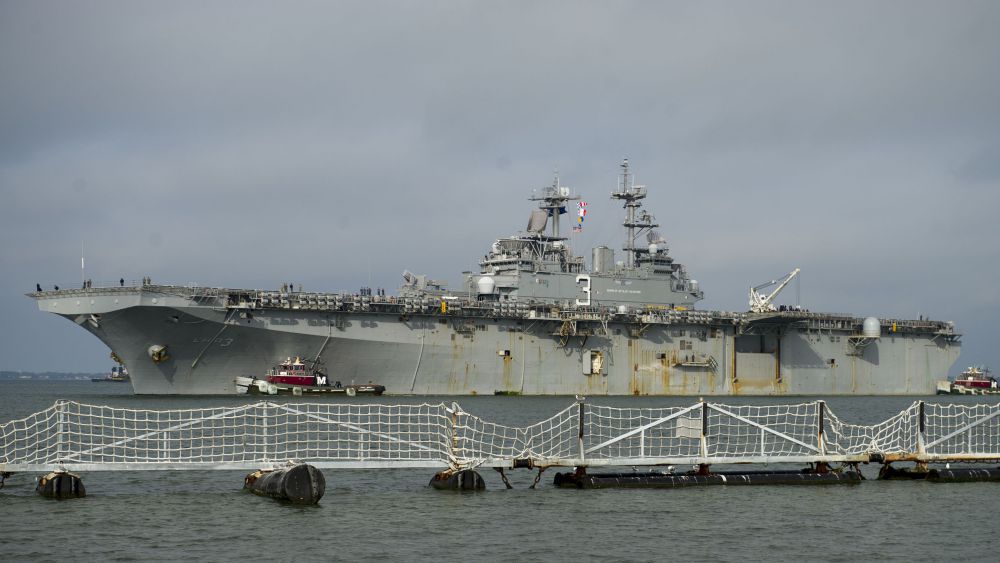USS Kearsarge Returns from Hurricane Relief Tour

The amphibious assault ship USS Kearsarge returned home to Naval Station Norfolk on Monday, ending her 68-day tour in support of disaster relief efforts in the Caribbean.
On August 31, Kearsarge and embarked elements of the 26th and 24th Marine Expeditionary Units (MEUs) prepared to depart Norfolk for Texas in response to Hurricane Harvey. "Besides delivering combat power from the sea, amphibious assault ships are ideally suited to deliver assistance and aid," said Kearsarge's CO, Capt. David K. Guluzian. "We can transport large amounts of manpower and supplies to areas in need using our small boats, landing craft and helicopters.
Before departing Naval Station Norfolk, Kearsarge took on more than 200 pallets of supplies, including baby food and formula, diapers, bedding, water bottles, coolers, batteries, towels, canned and dry food items and food service supplies.
However, Kearsarge never arrived in Texas. When she reached the waters off Florida, she was redirected to the Caribbean to prepare to respond to Hurricane Irma, which was approaching quickly. As soon as the storm passed the U.S. Virgin Islands, Kearsarge was on station to render aid. "The crew has been extremely adaptable," said Kearsarge's Command Master Chief Jason Knupp. "You would think somewhere between less than two days in port, dodging and then following hurricanes, there would be a hiccup along the way. Between the crew and all the embarked units – Marines, Seabees, squadrons – their work has been flawless."
Just two weeks after Irma ravaged the U.S. Virgin Islands, Kearsarge, along with the amphibious assault ship USS Wasp and the amphibious dock landing ship USS Oak Hill were redirected away from the area to prepare for the arrival of Hurricane Maria. As soon as Maria passed, aircraft from Kearsarge were flying search and rescue and aerial assessment missions over the U.S. Virgin Islands and Puerto Rico.
After the initial delivery of emergency supplies to the U.S. Virgin Islands and Puerto Rico, the mission turned to road and route clearance. Marines and Seabees were on the ground removing debris, enabling federal and Puerto Rican government employees and volunteers to begin service and infrastructure restoration.
Kearsarge also took on the mission to repair generators at hospitals in Puerto Rico, where teams from the amphib assessed the status of generators at 51 hospitals on the island. "In some cases, the teams were able to perform immediate repairs and get broken (or almost broken) generators working," said Guluzian. "In other cases, teams were able to relay a message to responders who could deliver the right assistance."
Kearsarge crewmembers who had family in Puerto Rico had the opportunity to to fly ashore to reconnect with their loved ones, and to survey the relief efforts in their neighborhoods and the state of local infrastructure. Operations Specialist Seaman Zabrina Adorno said she happy to see that her family and the town they live in were doing well, considering the circumstances. "It's definitely a relief knowing they have food and water," said Adorno. "They were fortunate to prepare well by getting gas and boarding up their windows before the storm."
As of November 5, over 4,500 sailors and Marines had carried out a tremendous amount of relief work in Puerto Rico and the USVI: 244 medical evacuations, 4.6 million pounds of relief supplies delivered, 100 miles of roads cleared and 1,600 flight hours of defense support to civil authorities, among countless other tasks completed. Additionally, during 68 days of supporting the relief effort, Kearsarge conducted more amphibious and flight operations than she would have undertaken in a routine six-month deployment.
